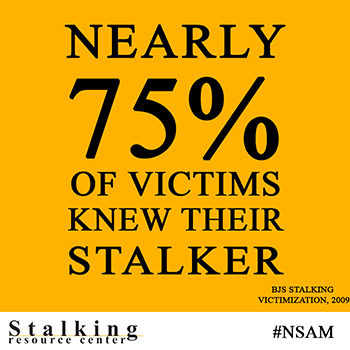Contact Us
To provide feedback on the Community Policing Dispatch, e-mail the editorial board at CPDispatch@usdoj.gov.
To obtain details on COPS Office programs, publications, and resources, contact the COPS Office Response Center at 800-421-6770 or AskCopsRC@usdoj.gov

U.S. Department of Justice
Office of Community Oriented Policing Services
Washington, DC 20530
Over 7 million people a year are victims of stalking and these victims range in age from high school students and young adults to senior citizens. In the US, approximately 15 percent of women and 6 percent of men have been a victim of stalking during their lifetimes.1 January is National Stalking Awareness month and a number of national and local events are scheduled across the country to highlight resources and encourage victims to get help.
“Stalking [is] a course of conduct [over time] directed at a specific person that would cause a reasonable person to feel fear. Stalking is serious, often violent, and can escalate [to assault and homicide].”2
The crime of stalking can include following victims, repetitive unwanted contact, sending unwanted gifts, property damage, and active threats to hurt either the victims or their family members. Technology is now being used in most stalking cases and can include tracking the victim with hidden cameras or global positioning systems (GPS), use of public records and online search services to follow victims, posting negative information online, and doxing.
“There is often an intersection between stalking and other crimes…property crimes, sexual assault crimes, domestic violence crimes,” states Detective Deirdri Fishel, State College Police Department.3
Up to 95 percent of stalking victims know the offender and 67 percent of stalking victims are also the victim of domestic abuse from their intimate partner. In addition, about 20 percent of stalkers use a weapon to harm the victim. Law enforcement and community partner outreach to end stalking will increase community safety and officer safety, since 20 percent of officer deaths in 2016 resulted from a response to disturbance calls, and the majority of those were domestic violence service calls.4
Many resources are available to agencies interested in implementing or expanding community outreach:
- Stalking Resource Center: Training and resources for law enforcement agencies and service organizations to effectively respond to stalking. Since inception, SRC has trained over 100,000 professionals.
- Stalking Awareness Month: Videos, media tools, event planning and other resources to raise awareness about the crime of stalking.
- National Center for Victims of Crime: A national, nonprofit organization that advocates for the rights of all victims, as well as providing resources and training for organizations that work with crime victims.
- Office for Victims of Crimes: A Department of Justice agency that administers the Crime Victims Fund, provides resources, training and technical assistance.
- Office on Violence Against Women: An agency with a focus on national policy to reduce violence against women and administer justice for victims of domestic violence, dating violence, sexual assault, and stalking.
 There are a number of publications and multimedia resources to learn more about the crime of stalking:
There are a number of publications and multimedia resources to learn more about the crime of stalking:
- Stalking: A guide for law enforcement on investigation and response best practices.
- Connecting the Dots - Recognizing and Responding to Stalking: A roll call video: A video for first responders on how to recognize and respond to stalking.
- OVC Help Series for Crime Victims: Stalking: Information on stalking with national help-line contacts.
- Responding to Stalking: Community corrections best practices for screening stalkers and coordinating with other agencies.
Elizabeth Simpson
Analyst (COPS)
Editor-in-Chief
References:
1 Matthew J. Breiding et al., “Prevalence and Characteristics of Sexual Violence, Stalking, and Intimate Partner Violence Victimization – National Intimate Partner and Sexual Violence Survey, United States, 2011”, Centers for Disease Control and Prevention Morbidity and Mortality Weekly Report, Vol. 63, No. 8 (2014): 7
2 http://victimsofcrime.org/our-programs/stalking-resource-center/stalking-information
3 https://www.youtube.com/watch?v=5RCBK5Mn55A
4 FBI 2016 Law Enforcement Officers Killed & Assaulted report. https://ucr.fbi.gov/leoka/2016
Subscribe to Email Updates
To sign up for monthly updates or to access your subscriber preferences, please enter your email address in the Subscribe box.






